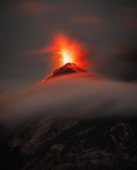
Newsnomics AJAY ANGELINA reoporter | ‘Fuego’ -- Spanish for fire – is one of the most active volcanoes in
central America has rumbled into activity overnight Saturday into Sunday, with molten rock oozing down its
slopes and ash belching 2 kilometers (more than a mile) into the sky. The volcano sits about 16 kilometers
(10 miles) from Antigua, the country's picturesque former capital and biggest tourist attraction.
“The Fuego volcano showed an increase in its activity, which in the last minutes has entered an eruption
phase (…). The eruption is mostly effusive accompanied by incandescent pulses from the lava source,” said the state-run Institute of Volcanology (Insivumeh) in a bulletin.
According to the institution, the eruption of the volcano, 3,763 meters high and located 35 km southwest of
Guatemala City, generates “constant weak, moderate and strong explosions”.
Local residents saw a sudden expulsion of lava on Saturday night that reddened the sky. "People here are used to experiencing this, and they look at it as normal," Demetrio Pamal, 28-year-old Indigenous Mayan farmer,
told AFP.
Authorities are monitoring the latest volcanic eruption and so far, no one has been evacuated, said Rodolfo
Garcia, the National Coordinator for Disaster Reduction (Conred), the entity in charge of civil protection.
“Wind might push the ash plume toward Guatemala City, which is 35 kilometers away,” he said.
With what happened on June 3, 2018, when Fuego volcano eruption sent rivers of lava pouring down its sides, devastating the village of San Miguel Los Lotes, killing 215 people and leaving a similar number missing.
"Now the authorities are already more alert and more active," said Jose Sul, another resident of Alotenango.
Guatemala boasts two other active volcanoes -- Santiaguito in the west and Pacaya in the south.
Fuego also adjoins the inactive Acatenango volcano — at 3,500 meters.










